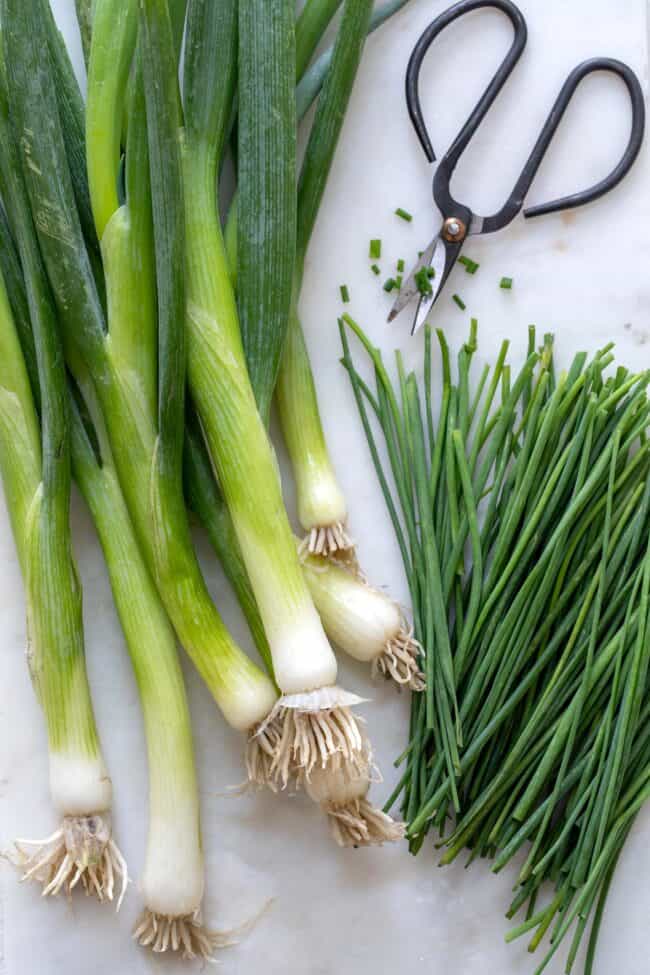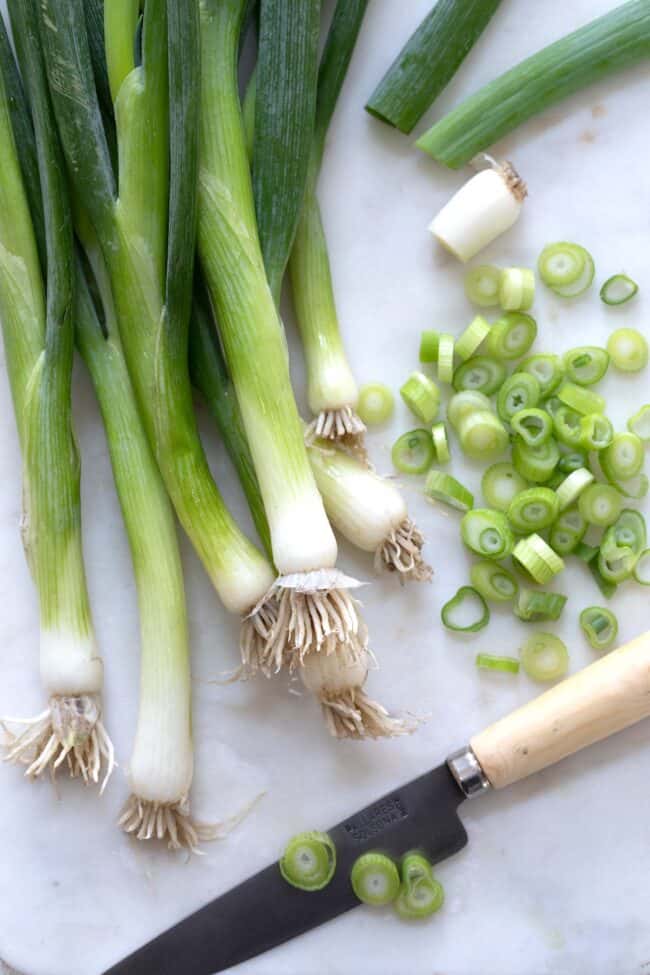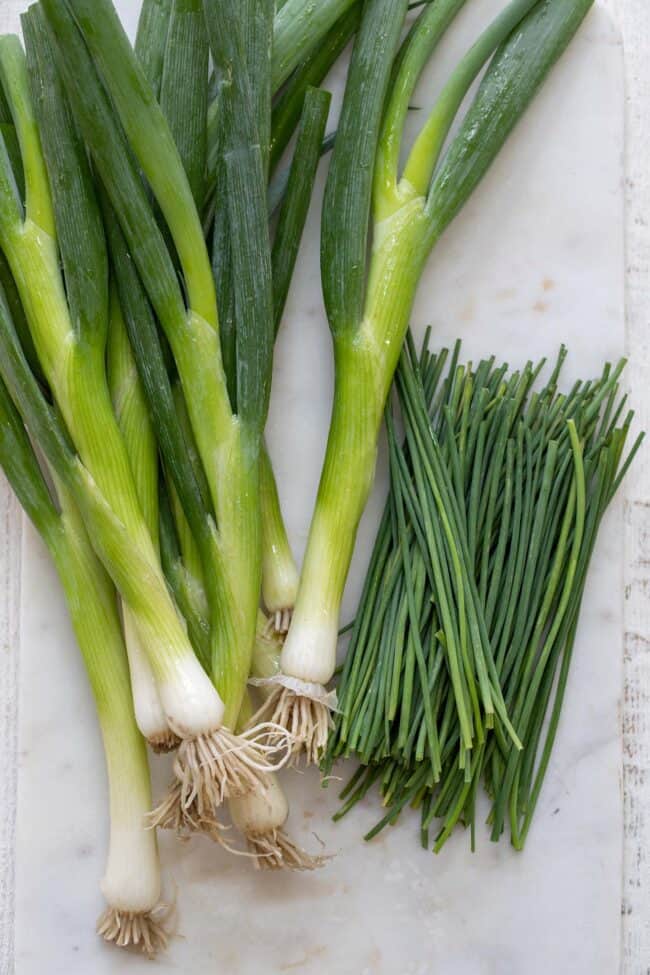Chives vs Green Onions
Here’s everything you need to know about Chives vs Green Onions. What are chives? What are green onions? Are green onions the same thing as scallions? ’What can you use as a substitute for green onions? How to choose them, store them, how to cut them and more.

Onions and their relatives, which include shallots, leeks, green onions, chives and garlic, are known as alliums.There are more than 500 types of alliums, and all of them are edible bulbing plants, and they all have a rather distinct sharp smell and flavor.
Whether you add onions, shallots, leeks, green onions, chives or garlic to any dish, alliums make just about everything taste better! Many recipes start out by cooking onions and garlic in a little olive oil or butter because they add a lot of flavor to a dish. Alliums are often referred to as aromatics because they help to create layers of flavor and an amazing aroma when they are cooked together.
Green Onions vs Chives
When comparing chives vs green onions, visually they look different, but how do they differ in other areas like taste and uses.
Chives
Chives are the smallest member of the allium family (Allium schoenoprasum). They have a hollow tube-like green colored leaves that look a little like blades of grass. Similar to green onions and leeks, chives have an onion-like flavor, but chives are classified as an herb. You can chop chives by using kitchen scissors to snip them or chop them with a sharp knife. Chives are added to salad dressings, soups, salads or used as a garnish on potatoes, roasted vegetables and more.
Green Onions
Green onions are immature onions with long hollow stems. They are a mild-flavored member of the allium family (Allium cepa). They are also called scallions and “bunching onions” that are considered “bulbless”. The term green onion is used interchangeable with scallions, but there is a minor difference. Green onions are harvested in the small bulb stage, but scallions are pulled from the soil while their tops are still green, but before a bulb has formed. The entire green onion is edible, even the roots. They bring a lot of color, texture and flavor to many dishes. Green onions are often added to soups and stews and salads or used as a garnish.
How To Choose Green Onions
Choose green onions with bright crisp tops. Avoid onions that have yellowing or wilted tops.
What’s The Best Way To Store Green Onions?
Green onions should be stored unwashed and wrapped loosely in a plastic bag. Store them in the refrigerator where they should last for up to 1 week. If you want green onions to last longer, then chop off about 3/4 of the green tips.
Before using green onions, rinse them in cold water to remove dirt and debris and also remove any limp or wilted green parts.
Green Onion Substitute
If you don’t have any green onions on hand, here are some easy substitutes that will work in a pinch for you:
- Shallots. Shallots are mild in flavor like green onions, so they’d be an easy substitute to use. Their texture is different, so the outcome won’t be quite the same.
- Leeks. Use the white and lighter green parts of the leek. Slice the leeks then rinse them under cold water, and use them in your recipe the same as you would green onions.
- Garlic. You can use garlic as a substitute for green onions, however, their flavors aren’t the same so the outcome won’t be quite the same.
How Many Tablespoons In One Green Onion?
Depending on the size of the onion, one chopped green onion equals about 2 tablespoons.
How To Choose Chives
Fresh chives are available year-round. Look for slender bright green stems without any brown or wilted stems.
What Is The Best Way To Store Chives?
Wrap chives in a paper towel and transfer to an air-tight plastic bag. Store in the refrigerator for up to one week. Rinse chives under cool water and pat them dry when you’re ready to use them.
Chives Substitute
It’s a little tricky to substitute chives because of their unique delicate onion flavor. Here are a few substitutes you can use, but you’ll want to decide if they should just be omitted from your recipe altogether
- Dried chives. Dried chives aren’t as flavorful as fresh, but they can be substituted in a pinch. One teaspoon dried chives equals one tablespoon of fresh chives.
- Green Onions. The green parts of green onions make a great substitute for chives. Use the same amount of minced green onion as you would use for fresh chives.
- Shallots. Minced shallots can be used as a substitute for chives, but the flavor is more robust, so use a little less minced shallot than the recipe calls for.
- Parsley. Parsley makes a good substitute for chives if you need a small amount to garnish a dish. Use the same amount of parsley as you would use for chives.
How Many Chives In One Green Onion?
One medium sized green onion equals about 2-3 tablespoons chopped chives.
Green Onions vs Chives Conclusion
Appearance
Chives are small, dark green and they look like blades of grass. They’re usually located in the herb section of the produce department at your grocery store. Green onions have long green stalks with white bulbs and are sold in bunches of 5 -6 green onions per bunch in the produce section at grocery stores.
Flavor
Chives have a delicate mild onion-like flavor. Green onions have a more robust onion-like flavor, especially the white parts. Use the white parts for if you want to add more flavor to a dish and the green parts for adding a more mild flavor. Green onions are more mild tasting than other onions.
Uses
Chives are most often used as a garnish for potatoes and roasted vegetables, but they are also added to soups and stews. Green onions are added to soups, stews, salads and stir-fries, but they can also be used as a garnish.



